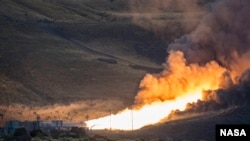A powerful new rocket booster intended one day to take humans to Mars was successfully test fired Tuesday at a facility in Utah, NASA said.
This was the second and last qualification ground test for the “most powerful rocket in the world,” with an uncrewed test flight of NASA’s Orion spacecraft scheduled for late 2018. Manned flights could begin within years if that test is successful.
“This final qualification test of the booster system shows real progress in the development of the Space Launch System [SLS],” said William Gerstenmaier, associate administrator for the Human Exploration and Operations Mission Directorate at NASA Headquarters in Washington. “Seeing this test today, and experiencing the sound and feel of approximately 3.6 million pounds [1.6 million kilograms] of thrust, helps us appreciate the progress we’re making to advance human exploration and open new frontiers for science and technology missions in deep space.”
The fiery test, which was conducted by NASA contractor Orbital ATK, only lasted two minutes, but that was enough for NASA to collect data on 82 aspects of the engine’s performance with the hope of eventually certifying the booster for flight.
The 47-meter booster was in a horizontal position and produced 1.6 million kilograms of rocket thrust.
Eventually, the SLS will be made up of two boosters and four main engines producing more than 4 million kilograms of thrust.
Manned trips to Mars could start sometime in the 2030's, NASA has said.
Here's a video of the test:









